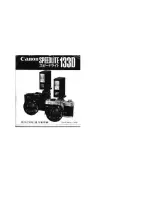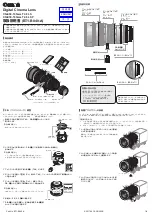
44
45
Advanced
Features
3
>
MANUAL
PHOTOGRAPHY FUNCTIONS
Set the Mode dial to “
>
”.
Use Manual mode to set any shutter speed and
aperture setting.
320 F5.6
ISO
200
6
N
Shutter speed
Setting the shutter speed
Turn the Command dial to select the shutter speed.
h
Shutter speed setting
30 sec. to 1/4000 sec. in 1/3 EV increments
Bulb (B)
●
!
See P.151 for information on EVs.
●
!
Use a tripod or cable release to prevent camera shake.
●
!
In shots with long exposures, noise (dots) may appear on the
image.
●
!
If the shutter speed is set to a speed faster than 1/2000 sec.,
smearing (white stripes) may appear in the image (
➡
P.151).
●
!
If the shutter speed is set to a speed faster than 1/1000 sec.,
the image may appear dark even if the flash is used.
1000 F4
ISO
200
6
N
Aperture
0
1
0
2
Setting the aperture
1
Hold down the “
D
” button.
2
Turn the Command dial to select aperture.
h
Aperture settings
Wide-angle: F2.8 to F11 in 1/3 EV increments
Telephoto: F4.9 to F11 in 1/3 EV increments
◆
The exposure indicator
◆
Use the exposure indicator on the screen as a guide
when setting the exposure.
When the brightness of the subject is outside the
camera’s brightness metering range, the exposure
indicator disappears on the screen.
1000 F3.6
ISO
200
6
N
Exposure indicator
Use this function for shots to get the correct brightness (exposure), such as shots with extremely
high contrast between the subject and the background.
Set the Power switch to “
q
”.
D
EXPOSURE COMPENSATION
PHOTOGRAPHY FUNCTIONS
Set the Mode dial to “
N
”, “
M
” or “
<
” mode.
2
1
500
F4
ISO
200
6
N
Exposure
compensation
indicator
1
Hold down “
D
” button.
2
Turn the Command dial to set the compensation
value.
The symbol indicating the compensation direction
(– or +) turns yellow. The “
D
” icon also turns yellow
while exposure compensation is being set and then
turns blue after setting is completed.
h
Compensation range
–2 EV to +2 EV (13 steps in 1/3 EV increments)
●
!
Exposure compensation cannot be used in the “
B
”, “
√
”,
“
À
”, “
U
”, “
,
”, “
/
”, “
>
” and “
r
” modes.
●
!
The screen brightness will increase or decrease depending
on the exposure compensation setting.
●
!
The following disables exposure compensation:
Shooting dark scenes in “
d
” Forced flash or “
b
” Red-eye
reduction mode.
0
1
0
2
3
This setting is retained when the mode is changed
or the camera is turned off (“
D
” icon appears). Set
the exposure compensation to “0” unless
compensation is required.
◆
To obtain the optimum brightness
◆
Adjust the exposure compensation according to the level of brightness or darkness in the image.
h
When the subject appears too bright
Try a negative (–) compensation setting.
This will make the overall image darker.
h
When the subject appears too dark
Try a positive (+) compensation setting.
This will make the overall image brighter.
■
Guide to compensation
i
Backlit portraits: +2 steps to +4 steps (+
DW
EV to +1
DQ
EV)
i
Very bright scenes (such as snowfields) and highly reflective subjects: +3 steps (+1 EV)
i
Shots made up predominantly of sky: +3 steps (+1 EV)
i
Spotlit subjects, particularly against dark backgrounds: –2 steps (–
DW
EV)
i
Scenes with low reflectivity, such as shots of pine trees or dark foliage: –2 steps (–
DW
EV)
◆
Bulb photography
◆
Setting shutter speed to “B” (Bulb) allows bulb shots to be taken. In bulb photography, the shutter
stays open for as long as the shutter button is held down (up to 30 seconds). Use a tripod or a
cable release to keep the camera steady.
Available Photography modes:
N
,
M
,
<
Содержание Finepix IS-1
Страница 77: ...153 152 Memo Memo ...
Страница 80: ...159 158 Memo Memo ...
Страница 82: ...163 162 Memo Memo ...
















































